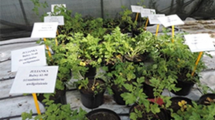Abstract
IT is well known that the number of stems formed by a potato plant profoundly affects the size and number of tubers produced1,2, and that some varieties tend to produce many stems and thus a high proportion of small unsaleable tubers3. If sprouted seed of such varieties with only one or two sprouts per set are planted, the resulting crop contains a high proportion of ware (table potatoes)4.
This is a preview of subscription content, access via your institution
Access options
Subscribe to this journal
Receive 51 print issues and online access
$199.00 per year
only $3.90 per issue
Buy this article
- Purchase on Springer Link
- Instant access to full article PDF
Prices may be subject to local taxes which are calculated during checkout
Similar content being viewed by others
References
Kawakami, K., Bull. Lab. Plant Breeding, Hyogo Agric. Coll., Japan (1952).
Kapoor, S. L., Indian J. Hort., 8, 11 (1951).
Rieman, G. H., et al., Amer. Potato J., 30, 98 (1953).
Thomas, W. L., and Eyre, P. W., “Early Potatoes” 198 (Faber and Faber, 1951).
Bushnell, J., Amer. Potato J., 19, 119 (1942).
Boyd, D. A., and Lessells, W. J., J. Agric. Sci., 44, 465 (1954).
Elbe, G., Dtsch. landw. Pr., 80, 48 (1957).
Author information
Authors and Affiliations
Rights and permissions
About this article
Cite this article
TOOSEY, R. Effect of Number of Sprouts per Set on Yield and Grading of Main-Crop Potatoes. Nature 182, 269–270 (1958). https://doi.org/10.1038/182269b0
Issue Date:
DOI: https://doi.org/10.1038/182269b0
This article is cited by
-
Studies on seed potato size and productivity
European Potato Journal (1963)
-
The influence of gibberellic acid seed treatment and seed spacing on yield and tuber size of potatoes
American Potato Journal (1963)
-
Influence of pre-sprouting on tuber number, size and yield of King Edward potatoes
European Potato Journal (1962)
Comments
By submitting a comment you agree to abide by our Terms and Community Guidelines. If you find something abusive or that does not comply with our terms or guidelines please flag it as inappropriate.



